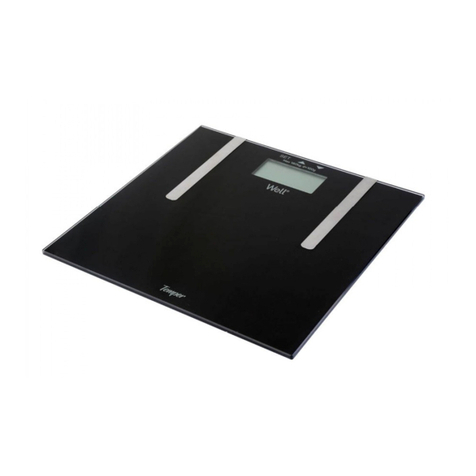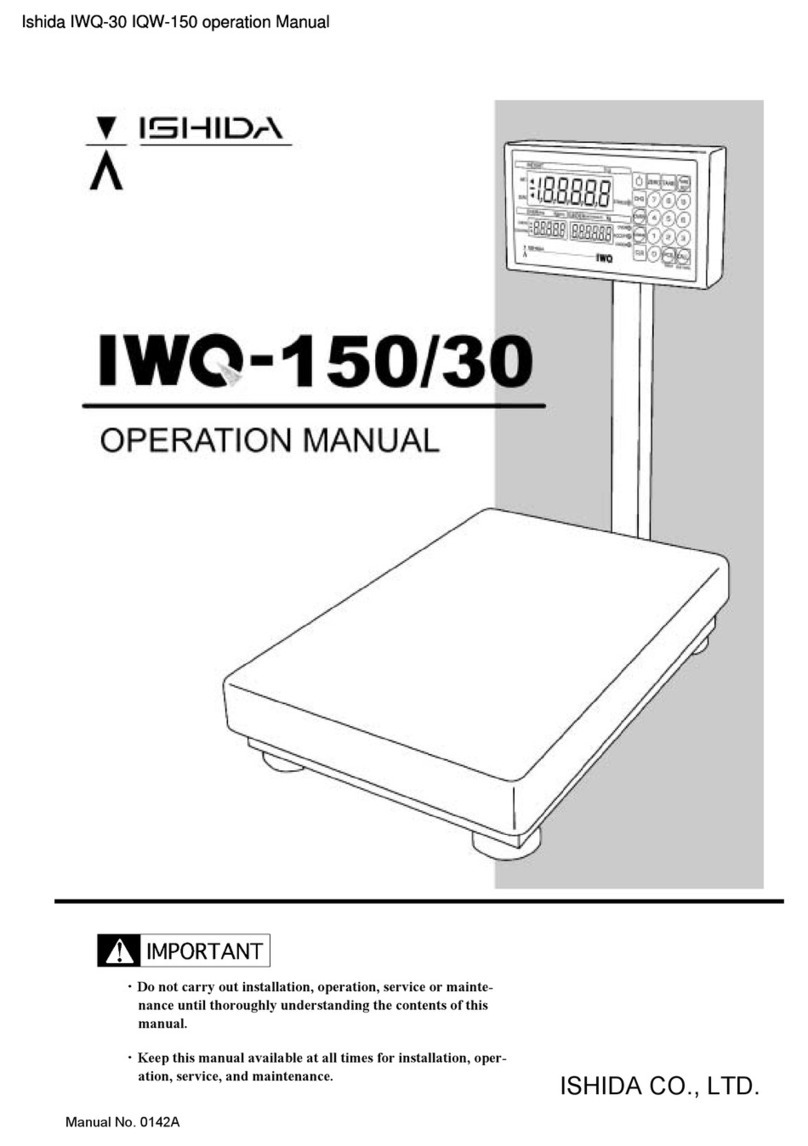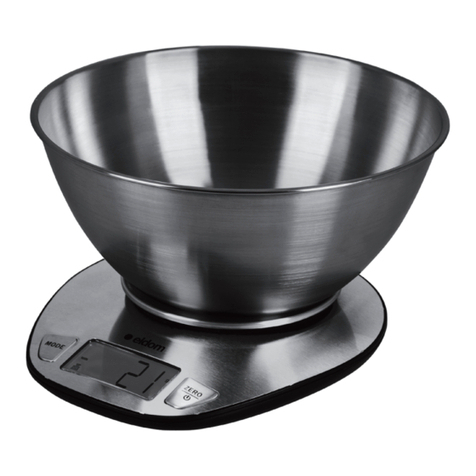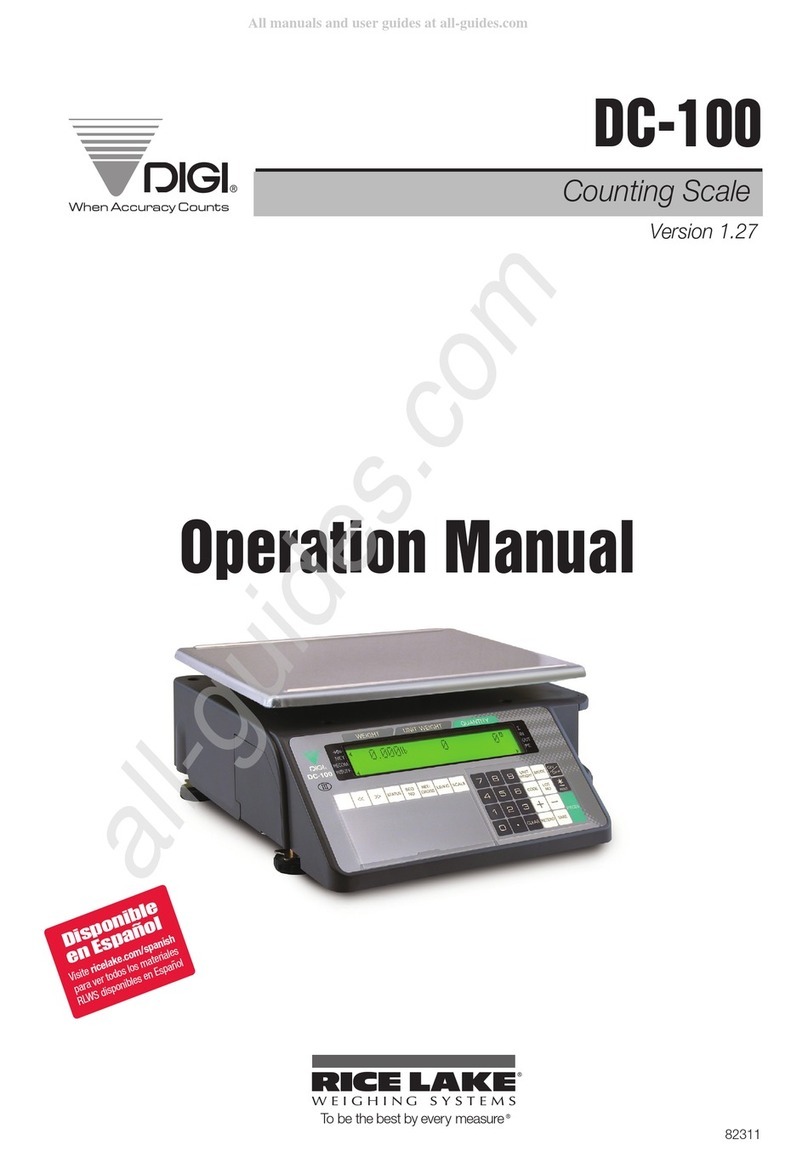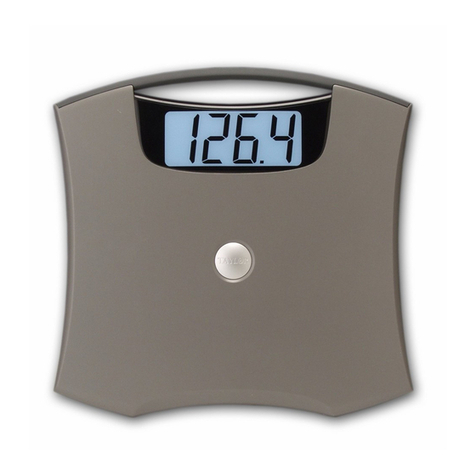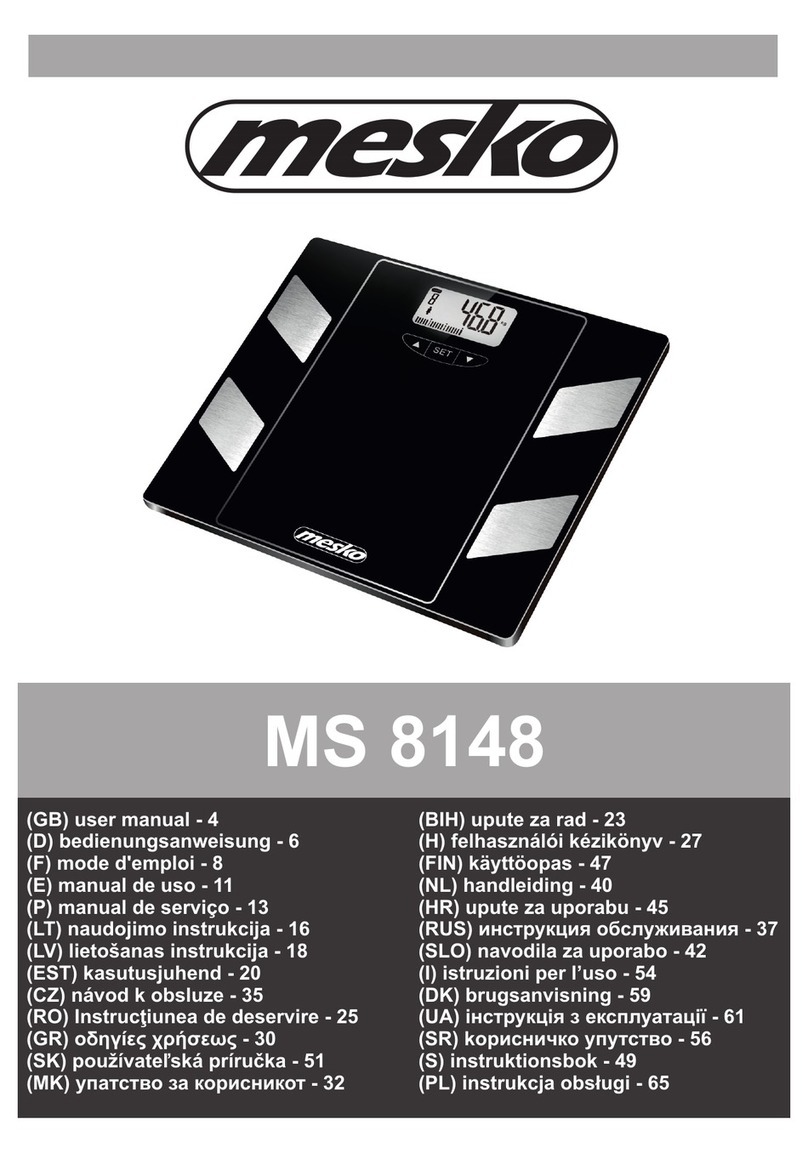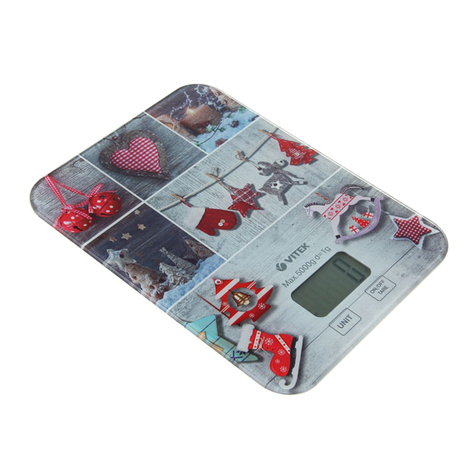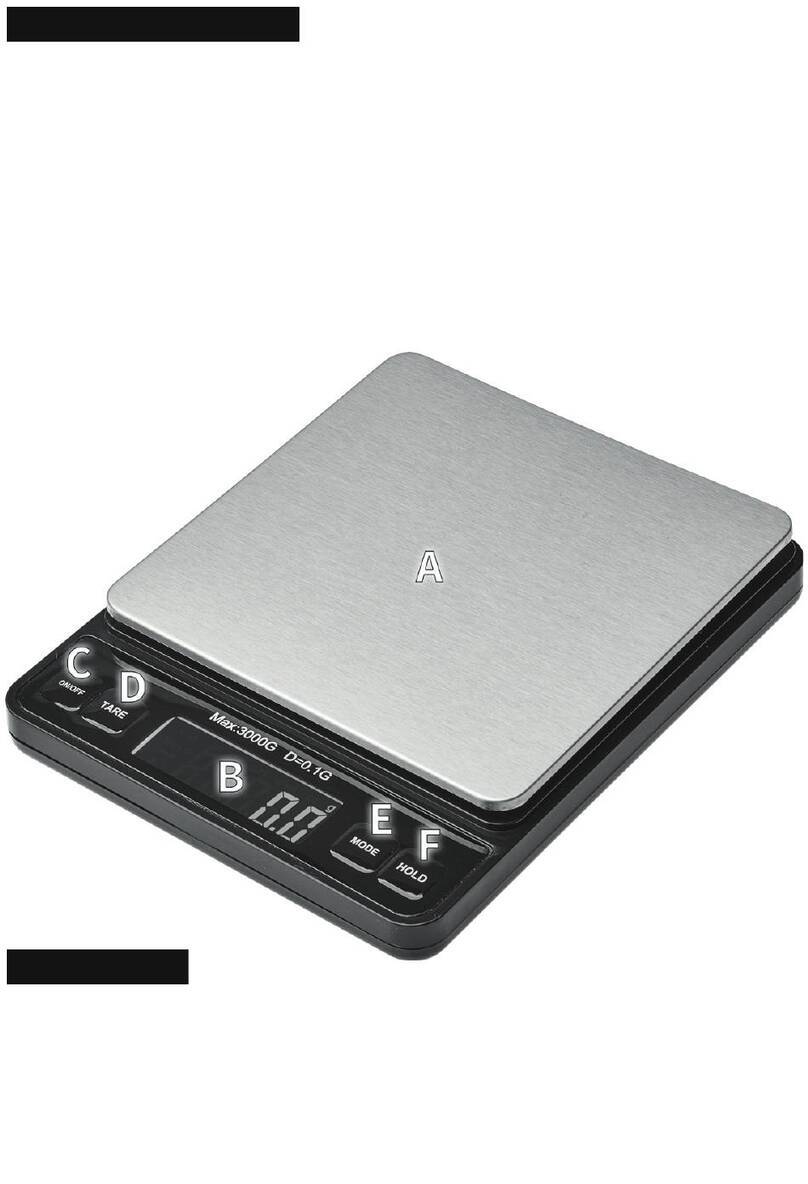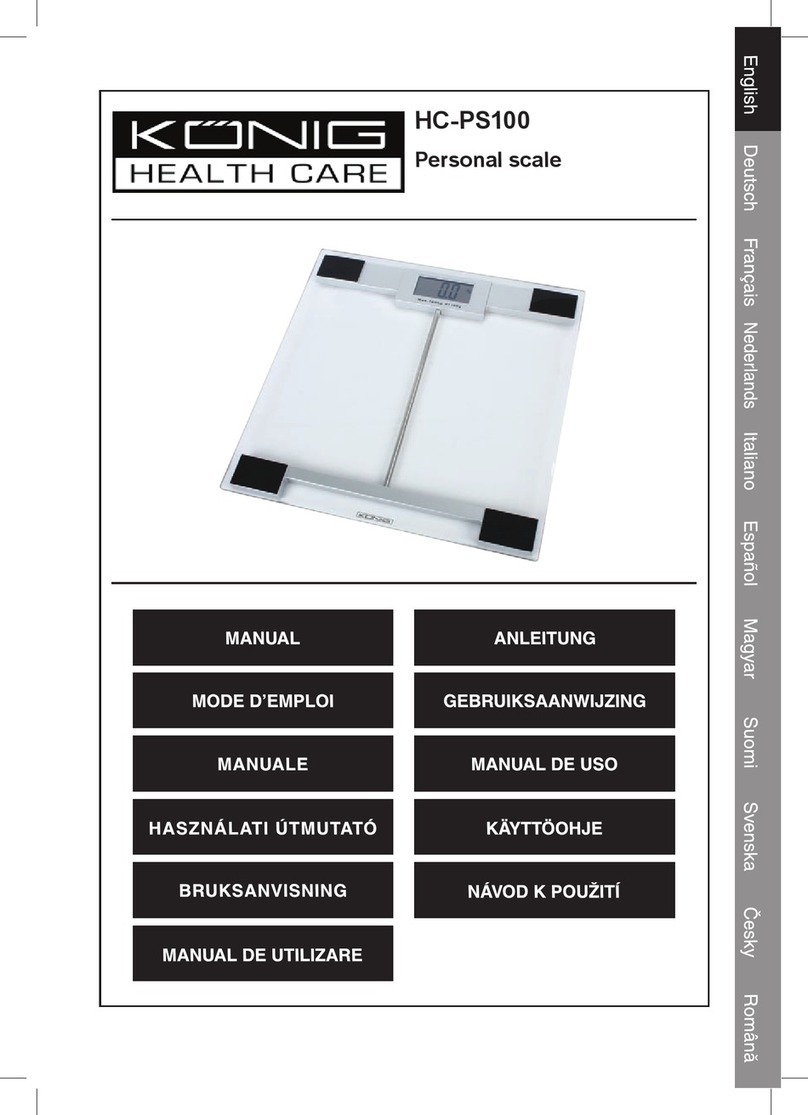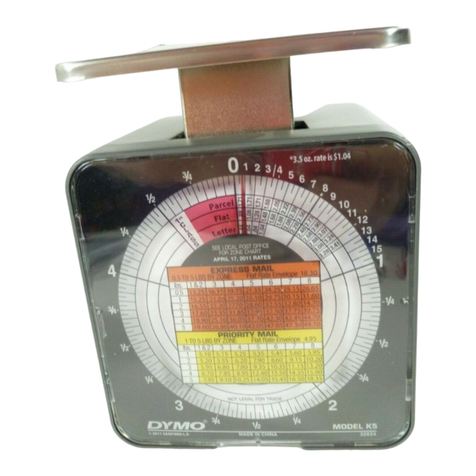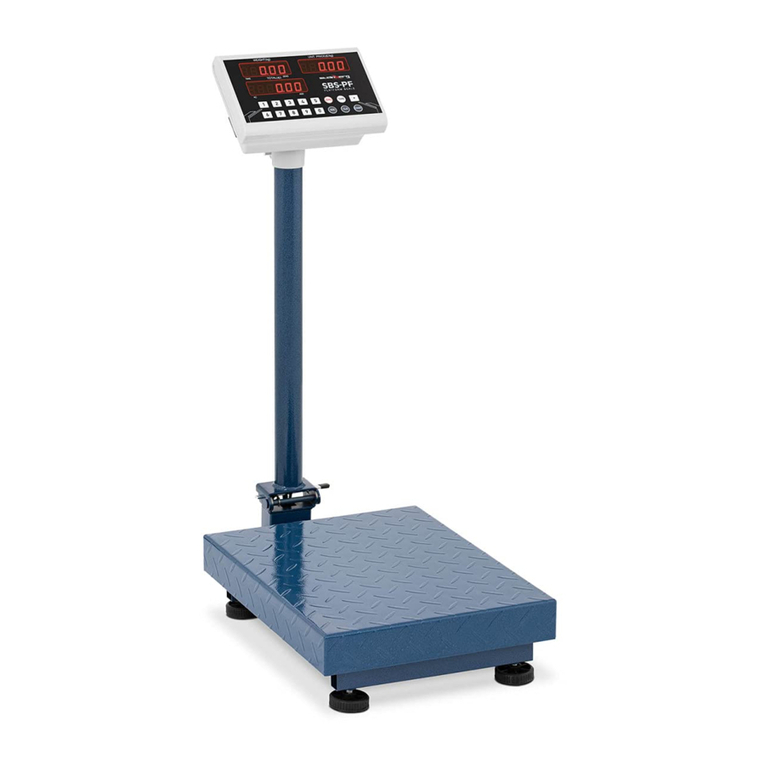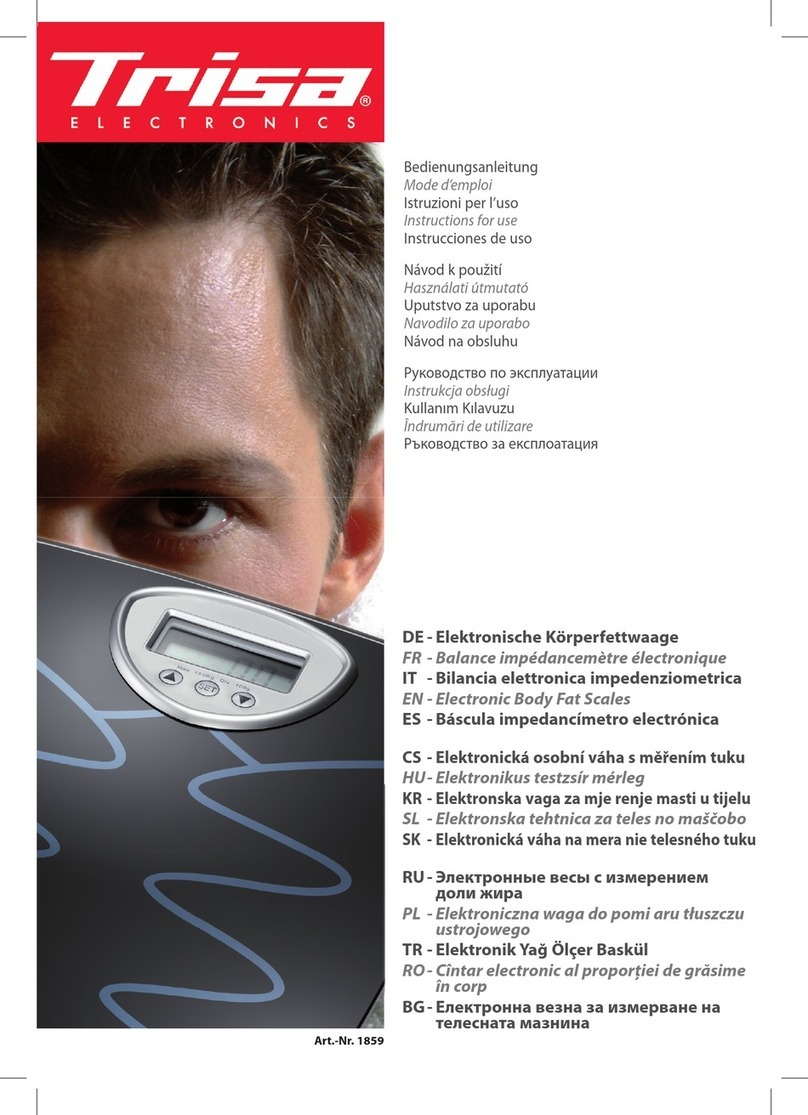Denver Instrument TP Series User manual

TP Series
Electronic Precision Balances/ Elektronische
Präzisionswaagen / Balances électroniques
de précision / Balanzas electrónicas de precisión
Operating Instructions / Betriebsanleitung /
Mode d’emploi / Instrucciones de funcionamiento

2
English – page 3
Deutsch – Seite 31
Français – page 59
Español – página 87

Contents
Warnings and Safety Precautions . . . . . . . . . . . . . . . . . . . . . . . . . . . . . . . . . . . . 4
Getting Started . . . . . . . . . . . . . . . . . . . . . . . . . . . . . . . . . . . . . . . . . . . . . . . . . . . 5
Operation . . . . . . . . . . . . . . . . . . . . . . . . . . . . . . . . . . . . . . . . . . . . . . . . . . . . . . . 9
Basic Weighing Function . . . . . . . . . . . . . . . . . . . . . . . . . . . . . . . . . . . . . . . . . . . 9
Calibration/Adjustment . . . . . . . . . . . . . . . . . . . . . . . . . . . . . . . . . . . . . . . . . . . 10
Application Programs . . . . . . . . . . . . . . . . . . . . . . . . . . . . . . . . . . . . . . . . . . . . . 12
Net-Total Formulation/Second Tare Memory . . . . . . . . . . . . . . . . . . . . . . . . . . . 12
Counting . . . . . . . . . . . . . . . . . . . . . . . . . . . . . . . . . . . . . . . . . . . . . . . . . . . . . . . . 13
Weighing in Percent . . . . . . . . . . . . . . . . . . . . . . . . . . . . . . . . . . . . . . . . . . . . . . . 14
Weigh Averaging . . . . . . . . . . . . . . . . . . . . . . . . . . . . . . . . . . . . . . . . . . . . . . . . . 15
Toggling between Weight Units . . . . . . . . . . . . . . . . . . . . . . . . . . . . . . . . . . . . . 16
Configuring the Balance . . . . . . . . . . . . . . . . . . . . . . . . . . . . . . . . . . . . . . . . . . . 17
Setting the Parameters (Menu Codes) . . . . . . . . . . . . . . . . . . . . . . . . . . . . . . . . 17
Balance Operating Menu (Overview) . . . . . . . . . . . . . . . . . . . . . . . . . . . . . . . . . 18
ISO/GLP-compliant Printout . . . . . . . . . . . . . . . . . . . . . . . . . . . . . . . . . . . . . . . . 20
Data Interface . . . . . . . . . . . . . . . . . . . . . . . . . . . . . . . . . . . . . . . . . . . . . . . . . . . . 22
Error Codes . . . . . . . . . . . . . . . . . . . . . . . . . . . . . . . . . . . . . . . . . . . . . . . . . . . . . . 23
Care and Maintenance . . . . . . . . . . . . . . . . . . . . . . . . . . . . . . . . . . . . . . . . . . . . . 24
Instructions for Recycling . . . . . . . . . . . . . . . . . . . . . . . . . . . . . . . . . . . . . . . . . . 26
Overview . . . . . . . . . . . . . . . . . . . . . . . . . . . . . . . . . . . . . . . . . . . . . . . . . . . . . . . . 27
Specifications . . . . . . . . . . . . . . . . . . . . . . . . . . . . . . . . . . . . . . . . . . . . . . . . . . . . 27
CMarking . . . . . . . . . . . . . . . . . . . . . . . . . . . . . . . . . . . . . . . . . . . . . . . . . . . . . . . 30
3
Contents

4
Safety
§To prevent damage to the equip-
ment, please read these operating
instructions carefully before using
your balance.
!Do not use this balance in a haz-
ardous area/location.
!Make absolutely sure to unplug
the balance from AC power before
you connect or disconnect a
peripheral device.
!Exposure to excessive electromag-
netic disturbance can cause the
readout value to change. Once the
disturbance has ceased, the instru-
ment can be used again in accor-
dance with its intended use.
Setting up the Balance
!Warning when using pre-wired
RS-232 connecting cables: The pin
assignments in RS-232 cables pur-
chased from other manufacturers
may be incompatible with DENVER
balances. Be sure to check the pin
assignment against the chart on
page 21 before connecting the
cable, and disconnect any lines
that do not match.
– Connect only DENVER accessories
and options, as these are optimally
designed for use with your DENVER
balance. Do not try to solve any
problems on your own. The opera-
tor shall be responsible for any
modifications to DENVER equip-
ment and for any connections of
cables or equipment not supplied
by DENVER and must check and, if
necessary, correct these modifica-
tions and connections. On request,
DENVER will provide information
on the minimum operating specifi-
cations (in accordance with the
standards for defined immunity to
interference).
– Do not open the balance housing.
If the seal is broken, this will result
in forfeiture of all claims under the
manufacturer’s warranty.
Warnings and Safety Precautions

5
Getting Started
Storage and Shipping Conditions
– Do not expose the balance to
extreme temperatures, blows,
shocks, vibration or moisture.
Unpacking the Balance
§After unpacking the balance,
check it immediately for any visible
damage
$If you see any sign of damage,
proceed as directed in the chapter
entitled “Care and Maintenance,”
under the section on “Safety
Inspection”
$Save the box and all parts of the
packaging until you have success-
fully installed your balance in case
you need to return it. Before pack-
ing your balance, unplug all con-
nected cables to prevent damage.
Equipment Supplied
– Balance
– Weighing pan
– Pan support (only on models with
a round weighing pan)
– AC adapter, plug type
Additionally supplied with TP-214
models:
– Shield ring
– Shield plate
– Dust cover
Additionally supplied with TP-303,
TP-303 I models:
– Glass draft shield with cover
Installation Instructions
When choosing a location to set
up your balance, observe the
following:
– Avoid placing the balance in close
proximity to a heater or otherwise
exposing the balance to heat or
direct sunlight
– Protect the balance from drafts
that come from open windows or
doors
– Avoid exposing the balance to
extreme vibrations during
weighing
– Do not expose the balance
to extreme moisture over long
periods
Conditioning the Balance
Moisture in the air can condense on
the surfaces of a cold balance when-
ever it is brought into a substantially
warmer place. If you transfer the bal-
ance to a warmer area, make sure to
condition it for about 2 hours at room
temperature, leaving it unplugged
from AC power.

6
Setting up the Balance
Balances with an Analytical Draft Shield
§Place the components listed below inside
the chamber in the order given:
– Shield plate
– Shield ring
– Pan support
– Weighing pan
Balances with a Glass Draft Shield
§Place the components listed below inside
the chamber in the order given:
– Draft shield base – place it on the balance so
that the edge for fitting the glass draft shield
faces upwards and turn it until it is firmly in
place
– Pan support
– Weighing pan
– Glass draft shield
– Draft shield cover – place it on the balance
so that the edge faces downwards
Balances with a Round Weighing Pan
§Place the components listed below inside
the chamber in the order given:
– Pan support
– Weighing pan
Balances with a Rectangular Weighing Pan
§Place the weighing pan on the balance

7
Connecting the Balance to AC Power/
Safety Precautions
Use only original Denver AC adapters
§Insert the right-angle plug into the jack
§The AC adapter rated to Class 2 can
be plugged into any wall outlet without
requiring any additional safety precautions
The ground is connected to the balance
housing, which can be additionally grounded
for operation.
Using a Non-Rechargeable/Rechargeable Battery:
for models TP-6101, TP-3101, TP-12
$A non-rechargeable or rechargeable battery
is not included with the equipment supplied
!Use only a commercially available non-
rechargeable or rechargeable 9-volt battery
!When using a rechargeable battery, always
use an external charger to recharge the bat-
tery
§Lay the balance/scale on its side
§Open the battery compartment:
Lift the compartment cover
§Insert the 9-volt (rechargeable) battery in
the
compartment
$Make sure to connect the positive and nega-
tive poles correctly
!All used batteries are classified as waste
that requires special handling (not “house-
hold” waste). Dispose of rechargeable bat-
teries in accordance with the applicable spe-
cial waste disposal regulations.
§Close the battery compartment:
Press down on the cover until it clicks into
place

8
Leveling the Balance
Level the balance any time you set it up in a
new location. Use only the 2 front feet of the
balance for leveling.
TP-3002, TP-1502, TP-6101, TP-3101, TP-12:
§Turn the 2 rear feet until they are in position
§Turn the 2 front feet as shown here in the
illustration until the air bubble is centered in
the level indicator
> In most cases, this will require several
adjustment steps
Anti-theft Locking Device
To protect against theft, use the mounting lug
on the rear panel of the balance.
§Secure the balance at the place of installa-
tion, for example with a chain or a lock

9
Operation
Basic Weighing Function
Preparation
§Turn on the balance:
Press [ON/OFF]
§To change configurations: See
the chapter entitled “Configuring
the Balance”
$To tare the balance: Press [TARE]
Additional Functions:
§To turn off the balance:
Press [ON/OFF]
Warmup Time
$To ensure accurate results, the bal-
ance must warm up for 60 minutes
before operation. Only after this
time will the balance have reached
the required operating temperature.
Example
Basic weighing
Step Key (or instruction) Display/Printout
1. Turn on the balance [ON/OFF]
Self-test is performed
2. Place container on balance +52.0 g
(here: 52 g)
3. Tare the balance [TARE] +0.0 g
4. Place sample in container +150.2 g
on balance (here: 150.2 g)

10
Calibration/Adjustment
Available Features
Calibration/adjustment can only be performed when
– there is no load on the balance,
– the balance is tared,
– the internal signal is stable.
If these conditions are not met, an error message is displayed.
Otherwise, the weight required for calibration/adjustment is displayed.
You can use any of the following weight units to calibrate/adjust:
g, kg*, lb (menu code 1. 4. x)
You can block calibration/adjustment of the balance:
– Select menu code 1. 5. 3
External calibration/adjustment
Step Key (or instruction) Display/Printout
1. Tare the balance [TARE] 0.0 g
2. Begin calibration [CAL] +1000.0
Calibration weight is displayed
without weight unit (here: 1000 g)
3. Place the indicated calibration 1000.0
weight on the balance
After calibration, the calibration +1000.0 g
weight is displayed with wt. unit
4. Remove the calibration weight 0.0 g
* = not on models with a readability of 0.1 mg

11
Calibration/adjustment with internal weight: Model TP-303I
Menu setting 1 5 2 required.
Step Key (or instruction) Display/Printout
1. Calibrate/adjust
the unloaded balance
2. Tare the unloaded balance [TARE] 0.0 g
3. Start calibration/adjustment [CAL]
4. Move the selector for the c
motorized weight into the
“calibration/adjustment”
position
5. Calibration/adjustment cC
is performed
(“CC” flashes on the display)
6. Remove weight:
Return the selector to the
initial position
7. The internal weight is removed
from the weighing system 0.0 g
cc
c

12
Application Programs
Net-Total Formulation/Second Tare Memory
With this application program you can weigh in components for formulation
of a mixture.
Preparation
Configure the Net-Total Formulation/Second Tare Memory application in the
operating menu: See “Configuring the Balance.” Menu code: 2.1.3
Example
Step Key (or instruction) Display/Printout
1. Place an empty container on +65.0 g
the balance
2. Tare the balance [TARE] +0.0 g
3. Add the first component +120,5 g
4. Store the first component [FUNCTION] 0.0 gNET
weight.
If the print format is set
to include data ID codes,
the following is printed N1 + 120.5 g
5. Add the next component +70,5 g
6. Store the 2nd component [FUNCTION] 0.0 gNET
weight.
7. Add further components, As described
if desired for steps 5 and 6
8. Display total weight and [CF] +191,0 g
fill to desired final weight

13
$Reference sample quantity:
Code 3. 3. 1 5 pcs
Code 3. 3. 2
10 pcs (factory setting)
Code 3. 3. 3 20 pcs
Code 3. 3. 4 50 pcs
Code 3. 3. 5 100 pcs
$Storage parameter
(display accuracy for counting)
Code 3. 4. 1 Standard resolution
(factory setting)
Code 3. 4. 2 With 10 times higher
resolution than stan-
dard
See also “Configuring the Balance”
Counting
Purpose
With the Counting program you can
determine the number of parts that
each have approximately equal
weight.
Preparation
§Configure the Counting application
in the operating menu:
See “Configuring the Balance”
Menu code: 2. 1. 4
Example
Determine an unknown piece count; weigh the preset reference sample quantity
Menu: Application program: Counting (menu code 2. 1. 4)
Reference sample quantity: 20 pcs (menu code 3. 3. 3)
Step Key (or instruction) Display/Printout
1. Tare the balance [TARE] 0.0 g
2. Display the reference sample [FUNCTION] ref 20 (briefly)
quantity (here: 20 pcs) >2 sec.
3. Place the reference sample +66.0 g
quantity (20 pcs) on the balance
(here: 66 g)
4. Start the application; if the print [FUNCTION] +20 pcs
format is set to include data
ID codes, the following piece
weight is printed wRef + 3.300 g
5. Weigh uncounted parts +174 pcs
(here: 174 pcs)
6. Display weight [FUNCTION] +574.2 g
7. Display quantity [FUNCTION] +174 pcs
8. Unload the balance 0pcs
9. Delete the reference value [CF]
10. Repeat the procedure starting from step 5, if desired.

14
Purpose
This application program allows
you to obtain weight readouts
in percent which are in proportion to
a reference weight.
Preparation
§Configure the Weighing in Percent
application in the operating menu:
See “Configuring the Balance.”
Menu code: 2. 1. 5
$Reference percentage:
Code 3. 3. 1 5 %
Code 3. 3. 2 10 % (factory setting)
Code 3. 3. 3 20 %
Code 3. 3. 4 50 %
Code 3. 3. 5 100 %
$Storage parameter
(display accuracy for counting)
Code 3. 4. 1 Standard resolution:
With stability (factory
setting)
Code 3. 4. 2 With 10 times higher
stability than standard
See also “Configuring the Balance”
Weighing in Percent
Example
Determine an unknown percentage: store the weight on the balance as a refer-
ence percentage
Menu: Application program: Weighing in Percent (menu code 2. 1. 5)
Menu: Reference percentage: 100 % (menu code 3. 3. 5)
Step Key (or instruction) Display/Printout
1. Tare the balance [TARE] 0.0 g
2. Display the reference [FUNCTION]
percentage: >2 sec. ref100
3. Place the reference weight +222.5 g
for 100 % on the balance
(here: 222.5 g)
4. Start the application; if the print [FUNCTION] +100.00 %
format is set to include data
ID codes the following is printed Wxx% + 222.500 g
5. Place an unknown weight +144.94 %
on the balance (here: 322.5 g)
6. Display weight [FUNCTION] +322.5 g
7. Display percentage [FUNCTION] +144.94 %
8. Unload the balance 0.00 %
9. Delete the reference percentage [CF]
10. Repeat the procedure starting from step 5, if desired.

15
Example
Determine the weight of a sample in extremely unstable ambient conditions
by calculating the average of 10 subweighing operations.
Menu: Application program: Weigh Averaging (menu code 2. 1.12)
Step Key (or instruction) Display/Printout
1. Tare the balance [TARE] 0.0 g
2. Display the number [FUNCTION] ref 10 (briefly)
of subweighs (here: 10) >2 sec.
3. Place sample on the balance 8888
(weight readout fluctuates)
4. Start measurement [FUNCTION] 8888
10
9
8
1
After 10 subweighs +275.5 gG
If the print format is set to include
data ID codes, the following is printed Res + 275.5 g
5. Unload the balance +275.5 g G
(stable display)
6. Delete the result [CF]
7. Repeat the procedure starting from step 3, if desired.
·
·
·
Weigh Averaging
Purpose
Use this program to determine
weights under unstable ambient con-
ditions. In this program, the balance
calculates the weight as the average
value from a defined number of
individual weighing operations,
called “subweighs” in this manual.
Preparation
§Configure the Weigh Averaging
application in the operating menu:
See “Configuring the Balance.”
Menu code: 2. 1.12
$Number of subweighs for weigh
averaging:
3. 3. 1 5 subweighs
3. 3. 2 10 subweighs
(factory setting)
3. 3. 3 20 subweighs
3. 3. 4 50 subweighs
3. 3. 5 100 subweighs
See also “Configuring the Balance”

16
With this application program you can toggle the display of a weight value
back and forth between two weight units.
Configure the “Toggle Weight Units” application in the operating menu:
See “Configuring the Balance.” Menu code 2.1. 2
Menu code Unit Conversion factor Abbr. on
printout
1. 7. 1 3. 1. 1 Grams 1.00000000000 o
1. 7. 2 ο3. 1. 2 οGrams 1 g
1. 7. 3 3. 1. 3 Kilograms1) 0.00100000000 kg
1. 7. 4 3. 1. 4 Carats 5 ct
1. 7. 5 3. 1. 5 Pounds 0.00220462260 lb
1. 7. 6 3. 1. 6 Ounces 0.03527396200 oz
1. 7. 7 3. 1. 7 Troy ounces 0.03215074700 ozt
1. 7. 8 3. 1. 8 Hong Kong taels 0.02671725000 tlh
1. 7. 9 3. 1. 9 Singapore taels 0.02645544638 tls
1. 7. 10 3. 1. 10 Taiwanese taels 0.02666666000 tlt
1. 7. 11 3. 1. 11 Grains 15.43235835000 GN
1. 7. 12 3. 1. 12 Pennyweights 0.64301493100 dwt
1. 7. 13 3. 1. 13 Milligrams 1000 mg
1. 7. 14 3. 1. 14 Parts per pound 1.12876677120 /lb
1. 7. 15 3. 1. 15 Chinese taels 0.02645547175 tlc
1. 7. 16 3. 1. 16 Mommes 0.26670000000 mom
1. 7. 17 3. 1. 17 Austrian carats 5 K
1. 7. 18 3. 1. 18 Tola 0.08573333810 tol
1. 7. 19 3. 1. 19 Baht 0.06578947437 bat
1. 7. 20 3. 1. 20 Mesghal 0.21700000000 MS
ο= Factory setting
1) = not for models with a readability of <0.1 mg
Function
§To toggle the display between the 1st and 2nd weight units:
Press the [FUNCTION] key
Toggling between Weight Units

17
Configuring the Balance
Setting the Parameters (Menu Codes)
You can configure your balance to meet individual requirements by selecting
from the parameters available in the menu.
Example: Adapt the balance to unstable ambient conditions
Menu code 1. 1. 4
Step Key (or instruction) Display
1. Turn off the balance [ON/OFF]
2. Turn the balance back on; [ON/OFF]
while all segments
are displayed [TARE] briefly 1.
$To navigate within a menu [TARE] 2.
level; the last menu option is repeatedly
followed by the first option 9.
1.
3. Select the 2nd menu level [PRINT] 1. 1.
4. Select the 3rd menu level [PRINT] 1. 1. 2 o
5. In Menu Level 3:
Select the desired option [TARE] repeatedly1. 1. 4
6. Confirm new setting;
the “o” indicates the currently
set option [PRINT] >2 sec. 1. 1. 4 o
$Select the next menu level
(here: move from the 3rd to [PRINT] 1.
the 1st level)
$Set other menu codes, if desired [PRINT], [TARE]
7. Store parameter settings [TARE] >2 sec.
and exit operating menu
or
$Exit operating menu
without storing changes [ON/OFF]
> Restart the application 0.0 g
·
·
·

18
Balance Operating Menu (Overview)
o Factory setting
√User setting
Menu 1 Balance 1.1. Adapt filter 1.1.1 Minimum vibration
functions 1.1.2 οNormal vibration
1.1.3 Strong vibration
1.1.4 Extreme vibration
1.3. Stability range 1.3.1 1/4 digit
1.3.2 1/2 digit
1.3.3 1 digit
1.3.4 ο2 digits
1.3.5 4 digits
1.4. Weight unit for 1.4.1 οGrams
calibration weight 1.4.2 Kilograms1)
1.4.3 Pounds
1.5. Calibration/adjustment 1.5.1 οExternal cal./adj.
1.5.2 Internal cal./adj. only on
model TP-303 I
1.5.3 Blocked
1.6. Auto zero 1.6.1 οOn
1.6.2 Off
1.7. Weight unit 1 See “Toggling between Weight Units”
2. Application 2.1. Program selection See the desired application
programs program description
3. Application 3.1. Weight unit 2 See “Toggling between Weight Units”
parameters 3.3. Reference qty or % See the desired application program
3.4. Display accuracy/ description
Weighing in Percent See the desired application program
description
5. Data 5.1 Baud rate 5.1.1 150 baud
interface 5.1.2 300 baud
5.1.3 600 baud
5.1.4 ο1200 baud
5.1.5 2400 baud
5.1.6 4800 baud
5.1.7 9600 baud
1) = not for models with a readability of 0.1 mg
Menu level 1
Menu level 2
Menu level 3
Factory setting
Menu item

19
5. Data interface 5.2 Parity 5.2.1 Mark
5.2.2 Space
5.2.3 οOdd
5.2.4 Even
5.3 No. of stop bits 5.3.1 ο1 stop bit
5.3.2 2 stop bits
5.4 Handshake mode 5.4.1 Software
5.4.2 Hardware
2 char. after CTS
5.4.3 οSoftware
1 char. after CTS
5.5 Communications mode 5.5.1 οSBI (ASCII)
5.5.2 GLP record
6. Print for 6.1 Manual/auto 6.1.1 Manual without stability
weighing print mode 6.1.2 οManual at stability
6.1.3 Automatic without stability
6.1.4 Automatic at stability
7. Print with 7.1 Line format of printout 7.1.1 Without data ID Codes
applications 7.1.2 οWith data ID Codes
programs 7.2 ISO/GLP-compliant 7.2.1 οOff
printout 7.2.2 For calibration/
adjustment only
7.2.3 Always on
7.3 Printout time 7.3.1 ο24-h format
7.3.2 12-h format
8. Extra 8.1. Menu 8.1.1 οParameter settings alterable
functions 8.1.2 Parameter settings read only
8.2. External 8.2.1 [CF] key
switch function 8.2.4 [TARE] key
8.2.5 ο[PRINT] key
8.2.6 [FUNCTION] key
8.2.8 [TARE] key
8.3. Power-on mode 8.3.1 Off/on (battery shuts off
for balance automatically after 3 min)
8.3.2 οStand-by/on
9. Menu-Reset 9.– Factory setting 9.– 1 Reset menu
9.– 2 Do not reset
Menu level 1
Menu level 2
Menu level 3
Factory setting
Menu item

20
ISO/GLP-compliant Printout
Features
You can have the parameters per-
taining to the ambient weighing con-
ditions printed before (GLP header)
and after (GLP footer) the values of
a weighing series.
These parameters include:
GLP header:
– Date
– Time at beginning of measurement
– Balance manufacturer
– Balance model
– Balance serial number
– Software version number
– Identification number of the
current sampling operation
GLP footer:
– Date
– Time at end of measurement
– Field for operator signature
!The record can only be output to
a Denver data printer 901042-1
Settings
§Set the following menu codes
(see “Configuring the Balance”):
– GLP-compliant record:
menu code 5 5 2
– ISO/GLP-compliant record after
calibration/adjustment only:
menu code 7 2 2 or ISO/GLP-com-
pliant record always on: menu
code 7 2 3
– Line format for printout:
With data ID codes – 22 characters:
menu code 7 1 2
– Printout date/time:
– 24-h format: menu code 7 3 1
– 12-h format: menu code 7 3 2
!No ISO/GLP-compliant record
is output if any of the following
settings are configured:
menu codes 6 1 3, 6 1 4 (automatic
printout) and 7 1 1
Function Keys
Press [PRINT] to output header and
first measured value.
> Header is output the first time
[PRINT] is pressed
To output header and reference data
automatically with an application
program active: Press [FUNCTION]
End application program:
End application program and output
GLP footer: Press [CF]
This manual suits for next models
8
Table of contents
Languages:
Other Denver Instrument Scale manuals
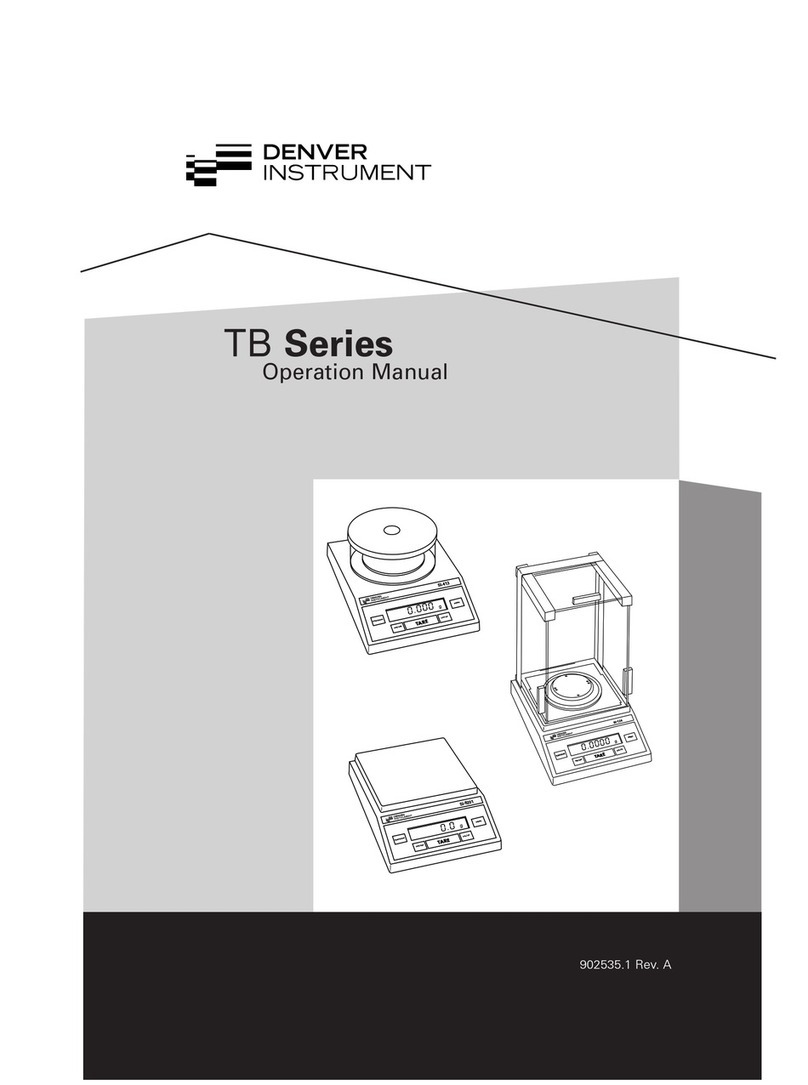
Denver Instrument
Denver Instrument TB-124 User manual

Denver Instrument
Denver Instrument PK-Series User manual
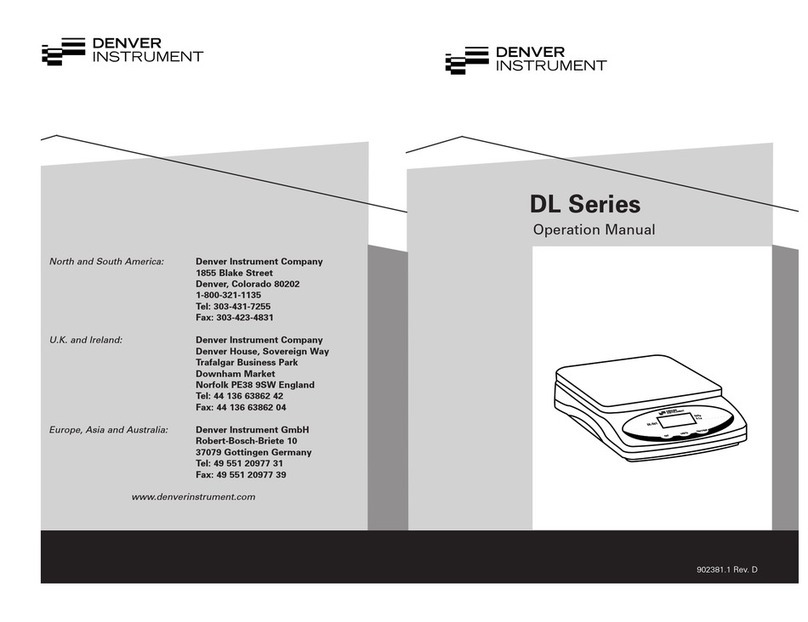
Denver Instrument
Denver Instrument DL series User manual
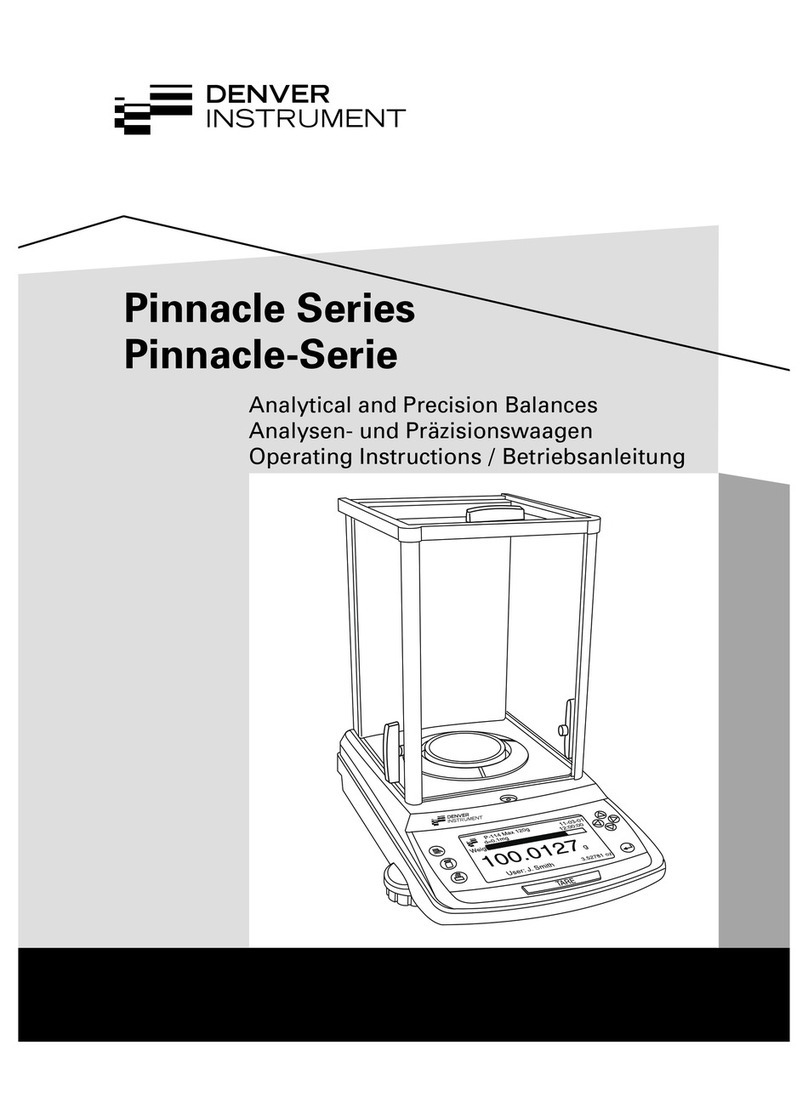
Denver Instrument
Denver Instrument P-114 User manual
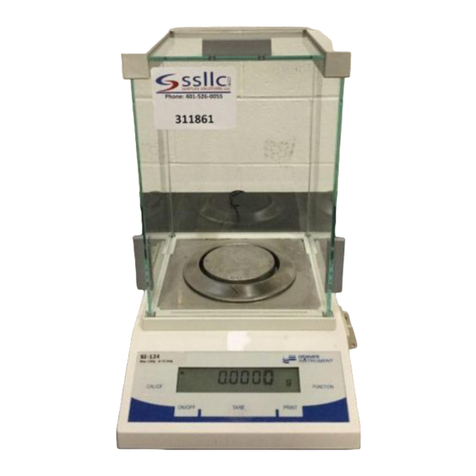
Denver Instrument
Denver Instrument TB Series User manual
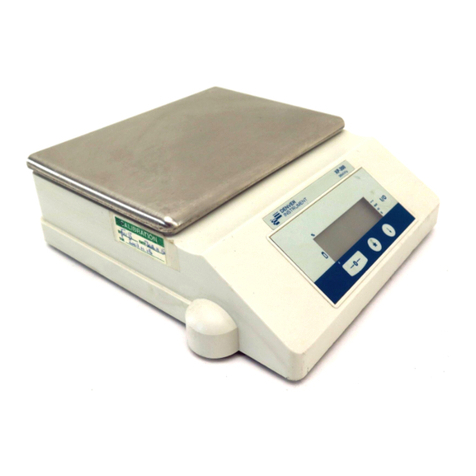
Denver Instrument
Denver Instrument XP Series User manual

Denver Instrument
Denver Instrument Tl-series User manual

Denver Instrument
Denver Instrument MAXX User manual
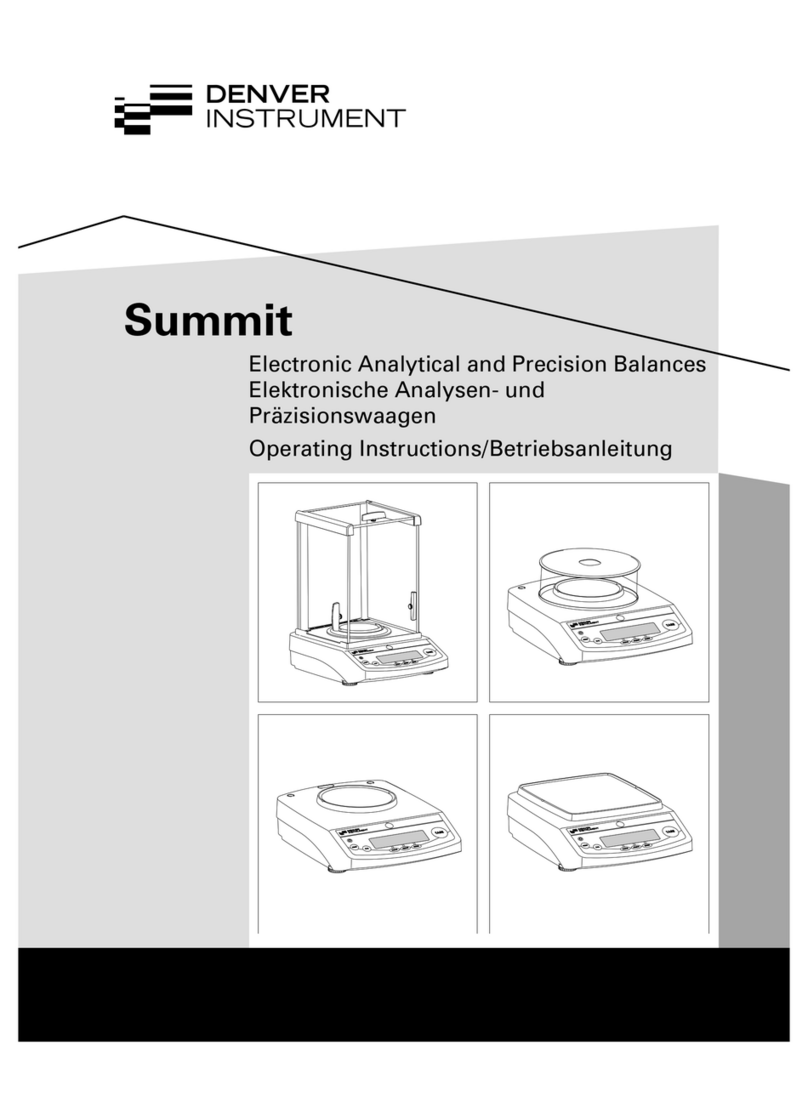
Denver Instrument
Denver Instrument Summit User manual
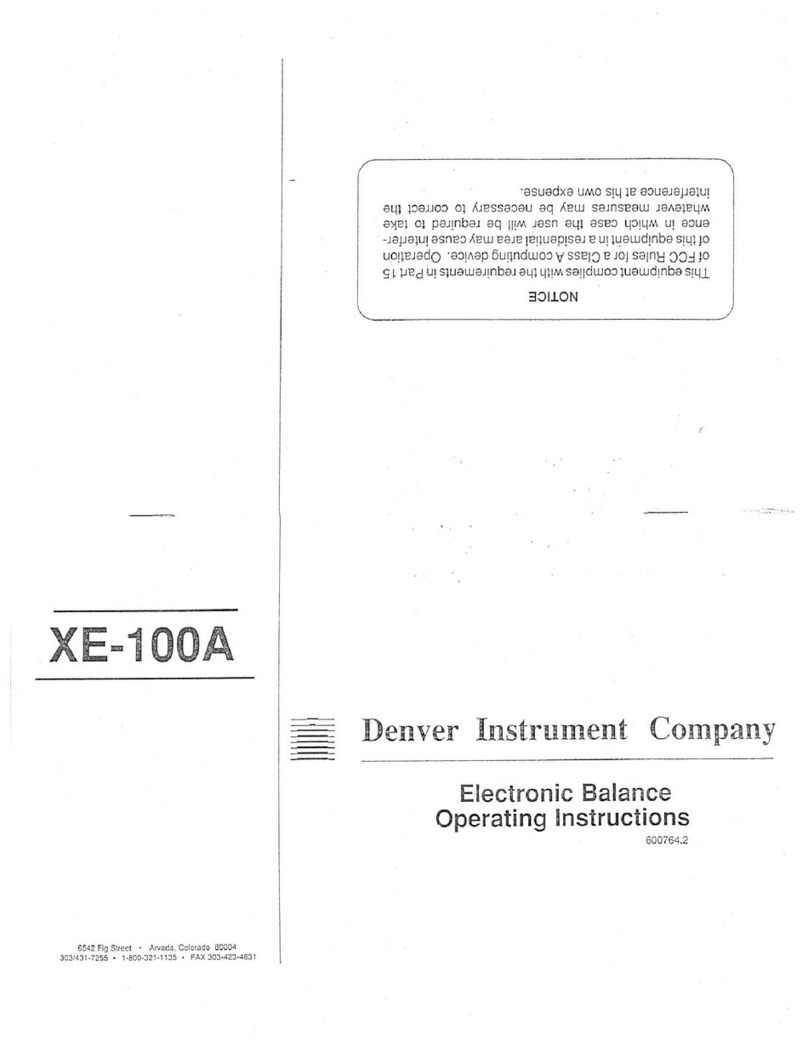
Denver Instrument
Denver Instrument XE-100A User manual



